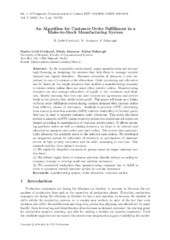Please use this identifier to cite or link to this item:
https://rfos.fon.bg.ac.rs/handle/123456789/638Full metadata record
| DC Field | Value | Language |
|---|---|---|
| dc.creator | Lečić-Cvetković, Danica | |
| dc.creator | Atanasov, Nikola | |
| dc.creator | Babarogić, Slađan | |
| dc.date.accessioned | 2023-05-12T10:15:14Z | - |
| dc.date.available | 2023-05-12T10:15:14Z | - |
| dc.date.issued | 2010 | |
| dc.identifier.issn | 1841-9836 | |
| dc.identifier.uri | https://rfos.fon.bg.ac.rs/handle/123456789/638 | - |
| dc.description.abstract | In the competitive environment, many manufacturers are increasingly focusing on designing the systems that help them to manage variable demand and supply situations. Dynamic allocation of demands is very important in case of customer order allocations. Order promising and allocation can be based on the simple sequence that enables a manufacturing company to receive orders unless there are some other priority orders. Manufacturing company can also manage allocations of supply to key customers and channels, thereby ensuring that they can meet contractual agreements and service levels in the priority that yields better profit. This paper will focus on a Make-to-Stock order fulfillment system facing random demand with random orders from different classes of customers. Available-to-promise (ATP) calculating from master production schedule (MPS) exhibits availability of finished goods that can be used to support customer order allocation. This order allocation system is adapted in MTS (make-to-stock) production model and all orders are treated according to maximization of customer service policy. It allows incoming purchase orders as well as existing inventory on hand to be selected and allocated to customer sale orders and back orders. The system then automatically allocates the available stock to the selected sales orders. We developed an integrated system for allocation of inventory in anticipation of customer service of high priority customers and for order promising in real-time. Our research exhibits three distinct features: (1) We explicitly classified customers in groups based on target customer service level; (2) We defined higher level of customer selection directly defined according to company strategy to develop small and medium customers; (3) We considered backorders that manufacturing company has to fulfill in order to maximize overall customer service for certain customers. | en |
| dc.publisher | CCC Publ-Agora Univ, Bihor | |
| dc.rights | openAccess | |
| dc.rights.uri | https://creativecommons.org/licenses/by-nc/4.0/ | |
| dc.source | International Journal of Computers, Communications and Control | |
| dc.subject | order allocation | en |
| dc.subject | manufacturing system | en |
| dc.subject | customer service | en |
| dc.title | An Algorithm for Customer Order Fulfillment in a Make-to-Stock Manufacturing System | en |
| dc.type | article | |
| dc.rights.license | BY-NC | |
| dc.citation.epage | 791 | |
| dc.citation.issue | 5 | |
| dc.citation.other | 5(5): 783-791 | |
| dc.citation.rank | M23 | |
| dc.citation.spage | 783 | |
| dc.citation.volume | 5 | |
| dc.identifier.doi | 10.15837/ijccc.2010.5.2238 | |
| dc.identifier.fulltext | http://prototype2.rcub.bg.ac.rs/bitstream/id/1102/634.pdf | |
| dc.identifier.rcub | conv_1296 | |
| dc.identifier.scopus | 2-s2.0-78049235132 | |
| dc.identifier.wos | 000283908700020 | |
| dc.type.version | publishedVersion | |
| item.cerifentitytype | Publications | - |
| item.fulltext | With Fulltext | - |
| item.grantfulltext | open | - |
| item.openairetype | article | - |
| item.openairecristype | http://purl.org/coar/resource_type/c_18cf | - |
| Appears in Collections: | Radovi istraživača / Researchers’ publications | |
This item is licensed under a Creative Commons License


